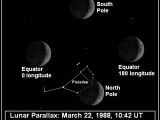How can astronomers perceive depth in space when determining the distance to certain mysterious bodies in and around our Milky Way galaxy? Well, using only one telescope doesn't really do the job so they use a mathematical solution that looks more like an optical illusion.
Astronomers use NASA's Spitzer's Space Telescope, due to its unique position, since it orbits the sun some 40 million kilometers behind Earth, and a depth-perceiving trick called parallax, to pinpoint celestial objects in the deep space.
"Forty years ago a visionary astronomer named Dr. Sjur Refsdal theorized that dark bodies could be located using parallax and a space telescope," said Andrew Gould of Ohio State University, Columbus, Ohio, who led the project. "It is truly remarkable that we have been able to prove him right with this Spitzer observation."
A stellar parallax is the change of angular position of two stationary points relative to each other as seen by an observer, caused by the motion of an observer. Simply put, it is the apparent shift of an object against a background caused by a change in observer position.
Thus, the parallax can determine the distance to various objects to help astronomers better understand the different components of our galaxy. However, precise parallax measurements of distance usually have an associated error, which can be approximated and thus applied to correct the final calculations.
The most famous example of using a parallax to calculate an astronomical distance is the first measurement of the distance between the Moon and the Earth.
As Jules Verne said in his famous book From the Earth to the Moon in 1865, "Up till then, many people had no idea how one could calculate the distance separating the Moon from the Earth. The circumstance was exploited to teach them that this distance was obtained by measuring the parallax of the Moon. If the word parallax appeared to amaze them, they were told that it was the angle subtended by two straight lines running from both ends of the Earth's radius to the Moon. If they had doubts on the perfection of this method, they were immediately shown that not only did this mean distance amount to a whole two hundred thirty-four thousand three hundred and forty-seven miles (94,330 leagues), but also that the astronomers were not in error by more than seventy miles (- 30 leagues)."
This sort of optical illusion is still the best way to calculate distances in space and it's the only way astronomers can say that a certain space object is located at X light-years from Earth.

 14 DAY TRIAL //
14 DAY TRIAL // 
